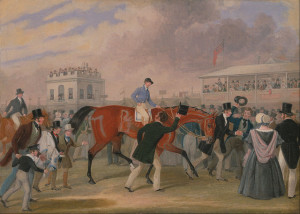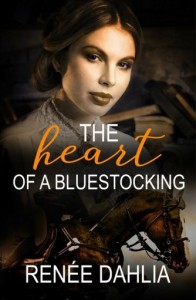 Renée Dahlia is an unabashed romance reader who loves feisty women and strong, clever men. Her books reflect this, with a side-note of dark humour. Renée has a science degree in physics. When not distracted by the characters fighting for attention in her brain, she works in the horse racing industry doing data analysis and writing magazine articles. When she isn’t reading or writing, Renée wrangles a partner, four children, and volunteers on the local cricket club committee as well as for Romance Writers Australia. To learn more about her and her books, visit her web site, and follow her on Facebook, Twitter, and Instagram.
Renée Dahlia is an unabashed romance reader who loves feisty women and strong, clever men. Her books reflect this, with a side-note of dark humour. Renée has a science degree in physics. When not distracted by the characters fighting for attention in her brain, she works in the horse racing industry doing data analysis and writing magazine articles. When she isn’t reading or writing, Renée wrangles a partner, four children, and volunteers on the local cricket club committee as well as for Romance Writers Australia. To learn more about her and her books, visit her web site, and follow her on Facebook, Twitter, and Instagram.
*****
In my Victorian-set historical romance, The Heart of a Bluestocking, a horse racing mystery threatens to pull apart the heroine’s family. This mystery is based on a real horse racing scandal that has never been solved. I did take some artistic licence and set my fictional scam in 1888 to suit my story. The real Trodmore Hunt scam occurred in 1898 in England, in the weeks leading up to the August bank holiday. The selection of this date is significant because it was the busiest weekend of racing in England, so the scammers could cover their tracks quietly.
The scam unfolds
Over a two week period leading up to the August bank holiday, the Clerk of the Course at Trodmore Hunt Club wrote to The Sportsman and The Sporting Life newspapers, firstly informing them on the meeting, following it up with early nominations, and later with the printed race cards. The quality of these communications was so precisely like the usual letters from racing clubs that the newspapers didn’t question their validity and published the race meeting details. The Sportsman couldn’t commit a journalist to cover the race day, as they were busy with the nearby Newton Abbot meeting, but noted that if one of the stewards would be obliged to send the result, that would be appreciated.
 Enter “Mr Martin.” He agreed to cover the event for The Sportsman for the fee of one guinea, with full results wired at the end of the meeting. As this day was one of the few public holidays in 1898, it was a huge day for the races, and very busy with bookies. The bookies did a roaring trade on Trodmore, bigger than expected for a minor meeting but not completely unexpected for a holiday. The evening papers published the results from the major meetings held that day but didn’t publish the Trodmore results until the next day.
Enter “Mr Martin.” He agreed to cover the event for The Sportsman for the fee of one guinea, with full results wired at the end of the meeting. As this day was one of the few public holidays in 1898, it was a huge day for the races, and very busy with bookies. The bookies did a roaring trade on Trodmore, bigger than expected for a minor meeting but not completely unexpected for a holiday. The evening papers published the results from the major meetings held that day but didn’t publish the Trodmore results until the next day.
Side Note: The telegraph first came into use in 1837, and by 1845, the Electric Telegraph Company had formed and the technology was about to take off. Australia became connected to the world in October 1872, and the telegraph across the Pacific was finally completed in 1902 to encircle the whole world. Therefore, by 1898, the idea that race results could be sent quickly to newspapers was old news!
Mr Martin wrote an effusive letter about the success of the meeting. The Trodmore results were published in The Sportsman. Most bookmakers paid out on the results, and Mr Martin walked away with the cash.
How the scam was detected
The other major racing paper, The Sporting Life, didn’t print the results, and a few wily bookies asked them to confirm the odds, refusing to pay out until such time. Mr Martin contacted The Sporting Life as the journalist who had represented The Sportsman at the meeting and agreed to write an article for The Sporting Life. However, he couldn’t send it through until the following afternoon. With the bookies furiously wanting to confirm the results, The Sporting Life decided to copy the results from The Sportsman to save time. The printer, perhaps tired or hungover, erroneously made a typo, putting Reaper as having won at 5/2 when The Sportsman had printed his price at 5/1.
Now the bookies were really paying attention. Which newspaper was right? And where was Trodmore anyway?
The Sportsman’s editor telegraphed Mr Martin and received no response. The addresses on the original letters were traced through the postal system, and it was quickly discovered that no place called Trodmore existed. The matter was handed over to police, and The Sportsman printed a retraction notice. The scam pulled thousands of pounds from bookies, and the perpetrator was never caught. The person posing as Mr Martin will forever be a mystery, although one theory is that he was a journalist with a strong racing background, as the scam required a solid working knowledge of how newspapers accepted race cards from minor meetings.
The Trodmore Hunt Scam was a simple scam, but for characters who have no knowledge of horse racing, it creates tension as they try to understand racing and the scam and save their families from the consequences. In The Heart of a Bluestocking, there are some alterations to the scam to keep the reader guessing, and most importantly, the characters solve the crime and fall in love.
*****
 A big thanks to Renée Dahlia!
A big thanks to Renée Dahlia!
**********
Did you like what you read? Learn about downloads, discounts, and special offers from Relevant History authors and Suzanne Adair. Subscribe to Suzanne’s free newsletter.
